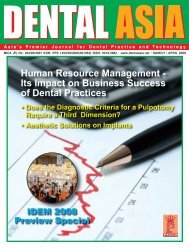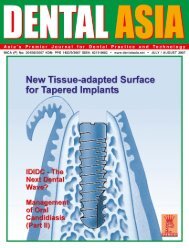Download - Dental Asia
Download - Dental Asia
Download - Dental Asia
You also want an ePaper? Increase the reach of your titles
YUMPU automatically turns print PDFs into web optimized ePapers that Google loves.
CLINICALUPDATE<br />
perceived outcomes does the work offer a person?<br />
How attractive does that person consider these<br />
outcomes to be? What kind of behavior must the<br />
person exhibit to achieve these outcomes? How<br />
does the person view his/her chance of doing what is<br />
asked? The key to understanding expectancy theory<br />
to understand an individual’s goal and the linkage<br />
between effort and performance, between<br />
performance and rewards, and between rewards<br />
and individual goal satisfaction. According to<br />
expectancy theory, various choices of behavior are<br />
evaluated according to their expectancy,<br />
instrumentality and valence. This can be summed up<br />
as a mathematical equation. Motivation is related to<br />
the mathematical product of expectancy,<br />
instrumentality and valence (fig. 1). People are more<br />
motivated with higher value of the product.<br />
Applications to Dentistry: It is important to decrease<br />
the effort/cost needed, increase the association<br />
between the effort/cost and the reward/benefit and<br />
increase the attractiveness of the reward/benefit.<br />
Conclusion<br />
It can be seen that different motivation theories are<br />
complementary to each other. No single theory can<br />
explain all the responses of the patients. An<br />
understanding to each theory can evolve a combined<br />
strategy that can motivate the most difficult patients.<br />
DA<br />
References<br />
1. Maslow A. Motivation and Personality. New York; McGraw-Hill; 1954.<br />
2. McGregor D. The Human Side of Enterprise. New York; McGraw-Hill; 1960.<br />
3. Herzberg F, Mausner B, Snyderman B. The Motivation to Work. New York;<br />
John Wiley; 1959.<br />
4. McClellend DC. The Achieving Society. New York; Van Nostrand Reinhold;<br />
1961.<br />
5. McClellend DC. Power: The Inner Experience. New York; Irvington; 1975.<br />
6. Ambrose ML, Kulik CT. Old Friends, New Faces: Motivation Research in the<br />
1990s. Journal of Management 1999;25:231-92.<br />
7. Skinner BF. Beyond Freedom and Dignity. New York; Knopf; 1972.<br />
8. Adams JS. Inequity in Social Exchanges. In: Berkowitz L (ed.). Advances in<br />
Experimental Social Psychology, vol. 2. New York: Academic Press; 1965;267-<br />
300.<br />
9. Lord RG, Hohenfeld JA. Longitudinal Field Assessment of Equity Effects on the<br />
Performance of Major League Baseball Players. Journal of Applied Psychology<br />
1979; Feb:19-26.<br />
10. Vroom VH. Work and Motivation. New York; John Wiley; 1964.<br />
11. Van Eerde W, Thierry H. Vroom’s Expectancy Models and Work-related criteria:<br />
A Meta-Analysis. Journal of Applied Psychology 1996;Oct:575-586.<br />
Footnotes<br />
1 Business Administration, the Hong Kong Shue Yan<br />
University<br />
2 Orthodontics, the University of Hong Kong<br />
Dr. Fanny Y. F. Young is an assistant<br />
professor in Business Administration,<br />
the Hong Kong Shue Yan University.<br />
Dr. Ricky W. K. Wong is a clinical<br />
associate professor in Orthodontics,<br />
the University of Hong Kong.<br />
<strong>Dental</strong> <strong>Asia</strong> • May / June 2008<br />
29





